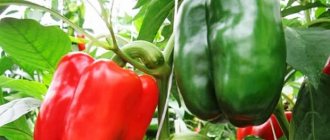Paprika is an aromatic spice that is obtained by processing one of the peppers of the Solanaceae genus. It can be capsicum, sweet, Bulgarian or chili. The spiciness of the seasoning depends on the type of vegetable. The color of paprika can vary from yellow or orange to rich red and brown.
Paprika is rich in vitamins A, B, E, C, as well as minerals - K, Ca, Mg, Zn and others. But it is still worth adding it to dishes in limited quantities. So what is paprika good for and can it be harmful to the body?
What is paprika?
Paprika is a spice made from a mixture of dried peppers from the Capsicum annum family. The bright red powder is truly versatile: it is used to enhance the color and flavor of dishes, dye Easter eggs and even fabric.
What does paprika look like?
The vibrant spice can come in the form of powder or flakes. The intensity of the shade directly depends on the type of pepper and the method of preparing the seasoning. Paprika flakes can be quite large (up to 10 mm) and include seeds and membranes.
What is paprika made from?
To make powdered seasoning, not only pepper pulp can be used, but also internal partitions, veins and even seeds. The hot type of spice is made from a mixture of bell and hot peppers. In Hungary, at least eight different varieties of pepper vegetables are used.
Types of spices
For everyday cooking at home, it is enough to use hot and sweet paprika. However, professional chefs distinguish up to seven different varieties:
- special: sweet, bright red;
- feledes: medium-hot, with a matte finish;
- delicate: deep red seasoning with the mildest flavor;
- pink: medium-hot taste, orange tint;
- noble: has a pleasant, pungent taste, noticeable aroma, almost burgundy color;
- spicy: has the highest degree of pungency, yellowish tint;
- gourmet: differs in coarser grinding, but the palette of shades and aromas may vary.
The above classification is typical for Hungarian manufacturers. The difference is noticeable only to gourmets with a delicate taste. But in other countries (for example, Spain) there are only 3 types of spices: hot, medium-hot and mild.
Chemical composition and energy value
The red powder is rich in vitamin A (6 grams - 21% of the recommended daily intake), B6 (14% of the daily value) and vitamins E (10%). The seasoning contains a large amount of dietary fiber, antioxidants and even proteins. And the low calorie content allows the powder to be consumed even by those who are on a diet.
A teaspoon of paprika contains only 6 calories.
Landing rules
In the middle climatic zone, paprika is planted only by seedlings - that is, it is necessary to first grow seedlings from seeds, and only then plant them in the garden. The only exceptions are the southern regions with a hot climate.
Seeds can be purchased in specialized stores, or collected yourself.
Important! It is not recommended to sow seeds that have lain for 4 years or more.
Sowing work is carried out at the end of February or beginning of March. Wrap the seeds in a damp cloth and leave for several days to germinate. Place the sprouted planting material in a weak solution of potassium permanganate for half an hour for disinfection. And at the final stage of preparation, it is advisable to keep the seeds in a growth stimulator for better germination. Now you can start planting.
The soil for planting is prepared as follows: mix 2 parts of garden soil and peat and 1 part of humus and sand. Mix all ingredients and freeze well. Next, to enrich the soil, add wood ash at the rate of 1 cup per bucket of soil. You can enrich the soil with a mixture of potassium, nitrogen and phosphorus fertilizers: in this case, take 20 g of potassium and nitrogen fertilizers and 40 g of phosphorus fertilizers.
Prepare plastic cups with fertile soil in advance (any other containers are possible). Make a 2 cm depression in the soil and drop a few grains at a time. Cover with soil, compact lightly and water with water at room temperature. Cover the containers with a transparent material (glass or film) and place in a warm, well-lit place. The covering material should be removed for some time every day for ventilation, and the soil should also be moistened regularly. But you shouldn’t overdo it with watering, as the sprouts may rot. When the sprouts hatch, remove the film or glass altogether.
When 2-3 leaves appear on the sprouts, it must be pruned, that is, each sprout should be planted separately so that the roots can receive all the necessary elements from the soil and develop normally. The sprouts are carefully transplanted into prepared containers with fertile, moist soil along with clods of soil on the roots. Lightly compact the soil and water the seedlings.
Now the sprouts should receive enough sunlight (at least 12 hours a day). We must also not forget about regular watering. For 2 weeks after the seedlings are supposed to be planted in the garden, hardening procedures will be useful - for this, it is advisable to take the containers outside every day and leave them for several hours.
When the height of the seedlings reaches 20 cm, they can be safely planted in open ground.
Important! Before planting seedlings, the soil should be well moistened so that it can be easily removed along with the soil. It is also advisable to transplant on a cloudy day or in the evening, since the sun's rays can burn the delicate, immature leaves.
To get a rich pepper harvest, you need to choose a good place to grow it. Pepper does not like drafts, windy areas, direct sunlight and very hot air. Therefore, the place should be protected from the winds and slightly in the shade.
The selected area must be prepared in the fall by digging and fertilizing. And before planting, it needs to be loosened and soaked in potassium and phosphorus fertilizers.
Peppers are transplanted in late May - early June. Prepare holes in the soil at a distance of 35 cm from each other. The distance between the beds is about 45 cm. The seedlings are carefully removed along with a lump of earth on the root and transferred to the hole. The stem is buried down to the first lower leaves, covered with soil and compacted. At the end, be sure to water it with water at room temperature and install long pegs next to each bush, to which they will be tied in the future.
Contraindications and possible harm
Moderate consumption of powder as a spice will only benefit the body. Seasonings made by unscrupulous manufacturers pose a potential health threat. The fact is that to give the spice a more attractive shade, dangerous dyes can be used. But even a completely natural product can have both benefits and harm. For example, the seasoning gets its spicy flavor from capsaicin, an alkaloid concentrated in the membranes of chili peppers. People with problems in the gastrointestinal tract should not use hot spices, because this is fraught with the development of complications and exacerbations.
Hot pepper
Hot chili peppers are also often called Bulgarian. They have a composition similar to sweet peppers. Their only difference is the special substance capsaicin, which gives the fruits a burning taste. The benefits of eating hot pepper have already been proven more than once.
>Hot peppers are used to make not only seasonings and pickles, but also add it to food to add spiciness. The burning fruits are widely used in medicine and cosmetology. Hot pepper can enhance the effect of the medicine and have a positive effect on the entire body as a whole.
How to select and store paprika?
Before purchasing spices, you need to study the composition. The use of dyes and flavors should be a reason to look for alternative options. Russian GOST allows the use of stems and amniotic parts of the plant for the production of paprika. This allows unscrupulous producers to increase production volumes. A good sign: a note that only red peppers were used for production.
Paprika should be stored in a cool, dark place in an airtight container. To maximize the shelf life, it is worth pouring the spice into a container that does not allow light to pass through. A regular metal can will do.
How to make paprika at home?
Making seasoning at home is very easy. It is best to start the process by growing sweet and bitter peppers. Vegetables need to be peeled from green parts and dried in the sun or in the oven. It is necessary to continue the drying process until the pepper can be easily crushed by hand. If you want to get paprika with a smoky aroma, then you need to heat the dried vegetables in a non-stick frying pan for 5-10 minutes. Grind the dry preparations with a pestle in a mortar or using a blender.
Paprika in cooking
The seasoning can be called universal, since it can be used for first courses, side dishes and salads. In most cases, you just need to add spice to the dish. But in order for paprika to fully reveal its taste, smell and color, the flakes need to be quickly fried in a small amount of olive oil.
Taste and aroma
The taste and spiciness of paprika directly depend on the type of pepper used. The powder can have all shades of red: from pink to burgundy, and emit a subtle aroma. But the taste varies from fiery-hot to delicate peppery.
Where is paprika added?
The spice can be added to marinades, gravies, and soups. Paprika is a main ingredient in traditional Hungarian, Spanish and South American dishes. There are even desserts with dry ground pepper drinks (for example, tomato-celery smoothie).
What spices does it go with?
The spice is mixed with curry and garlic powder. Cajun seasoning is made from paprika. Pepper powder can also be combined with thyme, oregano, and nutmeg.
What can you replace paprika with?
The choice of substitute directly depends on the type of paprika. To recreate the heat, you need to use any other type of pepper: chili, red ground or cayenne. If the recipe calls for sweet paprika, you can use dry tomato powder.
Recipes
The seasoning is included in a huge number of Hungarian and Spanish dishes. Ground paprika goes well not only with meat, but also with seafood and vegetables. The powder adds a piquant spice and bright tint to dishes.
Baked potato
A simple side dish that can serve as an independent dish. It is best to use a "smoky" spice.
Ingredients:
- butter – 50 grams;
- grated parmesan cheese – 5 tbsp. l.;
- salt - 1 tsp;
- flour - 3 tbsp. l.;
- paprika powder - 3 tbsp. l.;
- garlic powder - 1/2 tsp;
- 3 large potatoes - peeled and cut into portions.
In a marinating bag, combine flour, Parmesan, paprika, salt and garlic powder. Add chopped potatoes. Seal the bag and shake vigorously so that the marinade completely covers the potatoes. Melt the butter in a deep, heavy-walled frying pan. Pour out the mixture and bake at 200 degrees for 50-60 minutes.
Squid with paprika
Fried squid is a great appetizer to go with cold beer. Total cooking time takes approximately 30 minutes.
Ingredients:
- 2 cleaned squid carcasses;
- 2 eggs;
- 1 tbsp. lemon juice;
- 200 g flour;
- 1 tsp hot paprika;
- 1 tsp sea salt;
- 1/2 cup sunflower oil.
Cut the squid tubes into rings no more than 1 centimeter thick, sprinkle with lemon juice. In a separate container, mix the flour and seasonings, and in another, beat the eggs. Dip the squid rings into the eggs and then into the breading mixture, then fry in sunflower oil until cooked (about a minute on each side).
Serve with fresh herbs.
Goulash
A national Hungarian dish that has made the seasoning famous throughout the world. They say that properly prepared goulash is useful to eat after severe infectious diseases.
Ingredients:
- 1 kg. beef fillet;
- 30 ml vegetable oil;
- 3 medium onions, cut into half rings;
- 1 carrot, grated on a coarse grater;
- 1 bell pepper, cut into half rings;
- 3 cloves of garlic;
- 25 grams of dried paprika;
- 2 tsp. salt;
- 1 tsp. coarse black pepper;
- 1 glass of water;
- 1 can of tomato paste;
- ½ cup sour cream;
- 10 sprigs of fresh parsley.
Mix paprika, salt and pepper in a large bowl. Add the cubed beef tenderloin and stir until the seasoning mixture coats the meat in a thin layer. Set the workpiece aside.
In a deep, thick frying pan, heat 1 tablespoon of oil and fry the garlic, cut into thin slices. As soon as the garlic begins to brown, add the onion, carrots, and bell peppers and fry until soft. Pour in the rest of the oil, add the marinated meat and fry until browned. Then reduce the heat, pour the contents of the frying pan with sour cream, tomato paste and water, stir vigorously and simmer over low heat for 2-2.5 hours, stirring occasionally.
At the end add finely chopped parsley. Serve with boiled potatoes or beans.
Reviews
For a long time I thought that paprika and red hot pepper were the same thing, and therefore I was afraid to add these spices in large quantities. Someone once told me that paprika is not a chili pepper at all, but a powder made from a mixture of peppers, which are not always hot. And then I tried the taste of this wonderful supplement. Paprika is the best seasoning for me. I always add it to many dishes. If I want it spicier, I add a little grated chili pepper along with it. In general, I like paprika because it does not make the dish spicy. It gives a fantastic spicy taste. Meat, fish, vegetables - any food turns from simple into something incredibly tasty. Overall, I'm now a fan of this spice.
If you are tired of boring everyday food, you can enrich its taste by buying a small packet of paprika. This is a unique spice that in an amazing way makes any dish very tasty, refined, and gives a pleasant spicy aroma. And besides, paprika is useful. And how pleasant it can be, when you smell paprika, to plunge into another culture - as if you are moving to India or Mexico.
For me, paprika is, first of all, pepper, that is, the fruit of a certain plant, and only then a ground spice. I have been growing bell peppers for a long time. I chose the most optimal varieties for myself - Podarok Moldova and Korenovsky. Good varieties that are not demanding to care for. The bushes grow strong and productive. Peppers are very fleshy and thick-skinned. They go into salads and pickles. By the way, they can be dried and ground into a seasoning. They give off a very good aroma. So, if you are looking for suitable varieties for making canned food and spices, then these two varieties are perfect.
>
- Author: Maria Sukhorukikh
Rate this article:
- 5
- 4
- 3
- 2
- 1
(0 votes, average: 0 out of 5)
Share with your friends!











